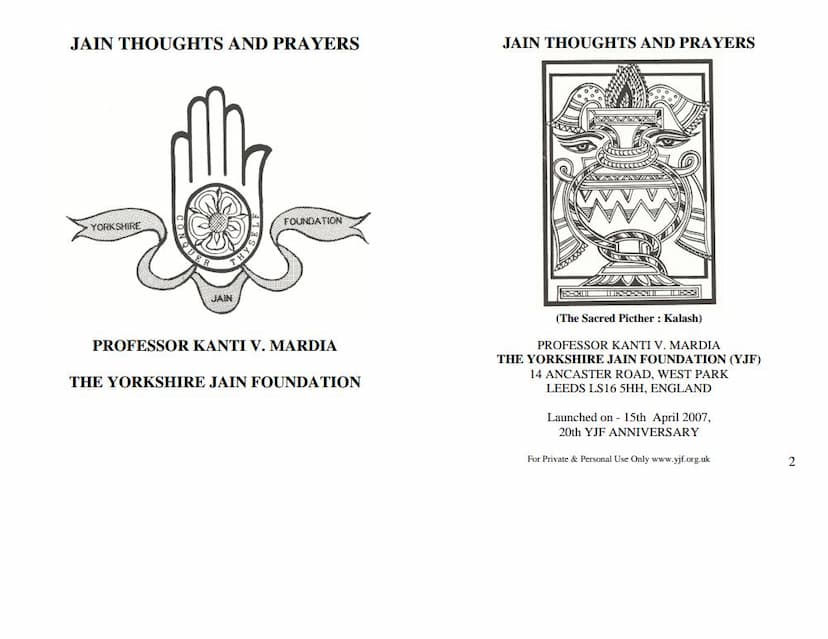Jain Thoughts And Prayers English Gujarati
Added to library: September 2, 2025

Summary
Here's a comprehensive summary of the Jain text "Jain Thoughts And Prayers English Gujarati" by Professor Kanti V. Mardia, published by Yorkshire Jain Foundation:
Overview:
"Jain Thoughts And Prayers" is a publication by the Yorkshire Jain Foundation (YJF), first compiled in 1990 and re-released in its second edition on April 15, 2007, coinciding with the YJF's 20th anniversary. Authored by Professor Kanti V. Mardia, this booklet aims to promote Jain values and thoughts, making them accessible and relevant to contemporary understanding. It serves as a resource for both understanding Jain philosophy and engaging in devotional practices. The book is divided into sections presenting Jain thought in English and Hindi, followed by prayers in Romanized script with English translations, and then the same prayers in their original script.
Core Jain Philosophy and Concepts:
The book delves into the fundamental principles of Jainism, highlighting:
- Self-Conquest (Self-Improvement): The central tenet is that each individual is responsible for their own destiny. Spiritual progress and liberation are achieved through self-effort, self-improvement, and the conquest of inner enemies like anger, greed, ego, and deceit. There is no creator God or external power that intervenes in this process.
- Karmic Matter: The soul (Jiva) is considered to be contaminated by karmic matter, which obscures its true qualities of infinite knowledge, perception, bliss, and energy. Actions (volitional activities) generate karmic matter, which in turn influences future experiences and rebirths. Good deeds lead to a weaker bond of karmic matter, while bad deeds create a stronger bond.
- Reincarnation: The cycle of birth, death, and rebirth continues until the soul achieves perfection and liberation (Moksha). The nature of each reincarnation is determined by the accumulated karmic matter.
- Consciousness: All living beings, from microscopic organisms to humans, possess consciousness to varying degrees. Even plants are considered to have consciousness. All are governed by the same natural laws.
- Reverence for Life and Non-Violence (Ahimsa): Practicing non-violence in thought, word, and deed towards all living beings is paramount for spiritual advancement. This principle underpins practices like vegetarianism and the avoidance of intoxicants, which are believed to foster passion.
- The Three Jewels (Ratnatraya): The path to self-conquest and liberation is summarized by Right Faith (belief in the self-regulatory universe, soul, and karmic matter), Right Knowledge (comprehension with non-absolutism), and Right Conduct (practice leading to self-conquest).
- Four Noble Truths: These are presented with their scriptural sources, outlining the soul's contamination by karma, the variation in beings due to karmic density, the soul's journey through rebirth cycles due to karmic bondage, and the causes of karmic influx (perverted views, non-restraint, carelessness, passions, and activities). Austerity is highlighted as a shield against new karmas and a means to shed old ones.
- Hierarchy of Life: A visual representation illustrates the degree of the soul's purity for different beings, from insentient objects and micro-organisms to plants, animals, and finally liberated souls.
- The Jain Symbol: Depicts the core principles of Non-Violence, Mutual Assistance of All Beings, Right Faith, Right Knowledge, and Right Conduct. The motto "Parasparopagraho Jivanam" (Mutual Assistance of All Beings) is prominently featured.
Inspirational Content and Guidance:
The booklet includes several sections offering practical and inspirational guidance:
- Inspiring Quotations: Features quotes from prominent figures like Albert Einstein and Omar Khayyam, connecting their thoughts to Jain principles, particularly regarding enlightenment, liberation from desires, and the ephemeral nature of worldly hopes.
- Letters between Mahatma Gandhi and Raychandbhai: This exchange highlights a key Jain ethical dilemma concerning self-preservation versus non-violence, emphasizing the spiritual aspirant's choice to prioritize spiritual welfare even in challenging circumstances.
- Jain Meditation: Provides a structured approach to meditation, focusing on stopping the influx of karmons and shedding existing karmic matter. It includes an initial checklist of principles to embrace and a main checklist for self-reflection on the five vows (Ahimsa, Satya, Asteya, Brahmacharya, Aparigraha).
- Twelve Reflections (Baarah Bhaavanaa): These are presented in both traditional and a more positive interpretation, covering themes like impermanence, helplessness, the cycle of rebirth, aloneness, the distinction between soul and body, the impurity of the physical form, the process of karmic influx and its cessation, the nature of the universe, the rarity of true insight, and the truth of the Jain path.
Prayers and Devotional Practices:
A significant portion of the book is dedicated to prayers and devotional hymns:
- Namokaar Mantra: The primary mantra of Jainism, saluting the five supreme beings (Arihants, Siddhas, Acharyas, Upadhyayas, Sadhus), with its transliteration and English translation.
- Chattaari Mangalam: A hymn declaring the auspiciousness of the Arihantas, Siddhas, Sadhus, and the teachings of the omniscient, with its transliteration and English translation.
- Maitri Bhaavnu: A Gujarati prayer expressing goodwill and compassion towards all beings, with its English translation.
- Aaratis (Worship by Lamps):
- Mahaavir Aarati: A devotional song celebrating Lord Mahavir, the 24th Tirthankara, recounting his life and virtues.
- Aadinaath Aarati: A devotional song honoring Lord Aadinaath (Rishabha Deva), the first Tirthankara.
- Mangal Divo: A prayer for auspiciousness and light.
- Pancha Parmesthi Aarati: A prayer honoring the five supreme beings (Pancha Parmesthi).
- Ksamaapan: A prayer for forgiveness and a blessing for universal well-being and peace, followed by a concluding affirmation of Jainism's principles.
- Baarah Bhaavanaa: The twelve reflections are also presented as prayers or meditative verses.
Publication and Aims:
The Yorkshire Jain Foundation (YJF) was established in 1987 with the objectives of promoting Jain values and thoughts, fostering academic and cultural exchanges, and making Jain rituals and scriptures more transparent with contemporary interpretations. This booklet is a direct publication of the YJF, with the second edition acknowledging contributions from various scholars and organizations. It is intended for private and personal use, with an aim to inspire further learning and practice of Jainism. The book also references various scholarly works on Jainism.